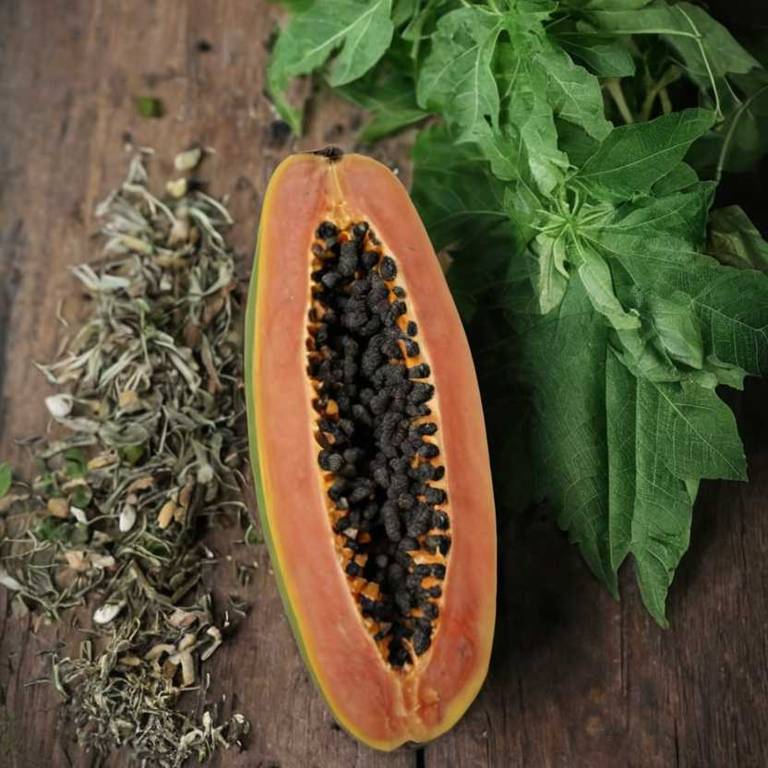By Leen Randell
Updated: Jul 21, 2024
10 Medicinal Constituents Of Carica Papaya (Papaya)

Carica papaya has active constituents such as papain, an enzyme with anti-inflammatory properties, and vitamin C, a powerful antioxidant.
These constituents contribute to the plant's medicinal properties, including wound healing and skin protection. Papaya's papain can also aid in protein digestion, benefiting individuals with digestive issues.
Regular consumption of papaya has been shown to improve overall health and well-being by reducing the risk of chronic diseases and promoting a healthy gut.
This article explains in details the 10 best active constituents of Carica papaya.
1. Papain
Carica papaya papain is a complex mixture of digestive enzymes extracted from the fruit's latex or pulp.
It contains cysteine proteases that break down proteins into smaller peptides and amino acids, making it an effective meat tenderizer and natural remedy for digestive issues such as indigestion and irritable bowel syndrome (IBS).
Papain has also been used in traditional medicine for its anti-inflammatory properties.
2. Protocatechuic acid
Carica papaya protocatechuic acid is a polyphenolic compound extracted from its fruit.
It has been shown to possess various pharmacological and biological activities, including antioxidant, anti-inflammatory, and antimicrobial properties.
Protocatechuic acid has been found to inhibit the growth of cancer cells and induce apoptosis (programmed cell death) in vitro, making it a potential natural agent for cancer prevention and treatment.
3. Fumaric acid
Carica papaya fumaric acid is a natural compound extracted from the fruit of the papaya plant.
It has been studied for its potential health benefits, including antioxidant and anti-inflammatory properties. Fumaric acid has been shown to have antimicrobial activity and may help protect against oxidative stress, making it a promising ingredient in the development of nutraceuticals and functional foods.
Further research is needed to fully understand its effects on human health.
4. Kaempferol 7-o-rutinoside
Carica papaya kaempferol 7-o-rutinoside is a flavonoid glycoside that has been isolated from the fruit of Carica papaya.
This compound exhibits antioxidant and anti-inflammatory properties, making it a potential candidate for the prevention and treatment of various diseases, including cancer and cardiovascular disorders.
Kaempferol 7-o-rutinoside has also been reported to possess antimicrobial activity, suggesting its possible use as an antiseptic agent.
5. Quercetin-3-o-glucoside
Carica papaya quercetin-3-o-glucoside is a bioactive flavonoid glycoside found in the fruit of Carica papaya.
This compound has been identified for its potential health-promoting effects, including antioxidant, anti-inflammatory, and antimicrobial properties. It has been shown to exhibit cytotoxic activity against various cancer cell lines, making it a promising candidate for the development of new cancer treatments and prevention strategies.
Further research is needed to fully elucidate the biological activities and therapeutic potential of this compound.
6. Chlorogenic acid
Carica papaya chlorogenic acid is a type of phenolic compound found in the fruit's leaves and seeds.
This antioxidant-rich compound has been extensively studied for its potential health benefits, including anti-inflammatory and antimicrobial properties.
Research suggests that chlorogenic acid may help reduce the risk of chronic diseases such as cardiovascular disease, diabetes, and certain types of cancer by inhibiting oxidative stress and cell damage.
7. Benzyl isothiocyanate
Carica papaya benzyl isothiocyanate is a naturally occurring compound extracted from the leaves and seeds of the plant.
It has been studied for its potential health benefits, including antioxidant, anti-inflammatory, and antimicrobial properties. Benzyl isothiocyanate has also shown activity against cancer cells and may have a role in protecting against certain diseases.
Its unique chemical structure and bioactive compounds make it an area of interest for further research and potential applications.
8. Glutathione
Carica papaya glutathione is a naturally occurring antioxidant found in the fruit of the papaya plant.
It is a powerful reducing agent that has been shown to have various health benefits, including protecting against oxidative stress and inflammation, improving skin texture and tone, and even exhibiting anti-cancer properties.
Glutathione from papaya extract is often used as an active ingredient in skincare products due to its ability to neutralize free radicals and promote a youthful appearance.
9. Papain inhibitor
Carica papaya papain inhibitor is a protein that binds to and inactivates papain, an enzyme responsible for digesting proteins.
Papain inhibitor helps regulate the activity of papain, preventing it from degrading proteins too quickly or excessively, which can lead to tissue damage.
This inhibition is essential for maintaining the integrity of the fruit's tissues and ensuring proper ripening and senescence.
10. Catechin
Carica papaya catechin is a type of flavonoid compound found in the fruit and leaves of the papaya plant.
It has been extensively studied for its potential health benefits, including antioxidant, anti-inflammatory, and antimicrobial properties.
Catechin from papaya has been shown to exhibit strong scavenging activity against free radicals, making it a promising natural agent in the prevention of various diseases such as cancer, cardiovascular disease, and neurodegenerative disorders.